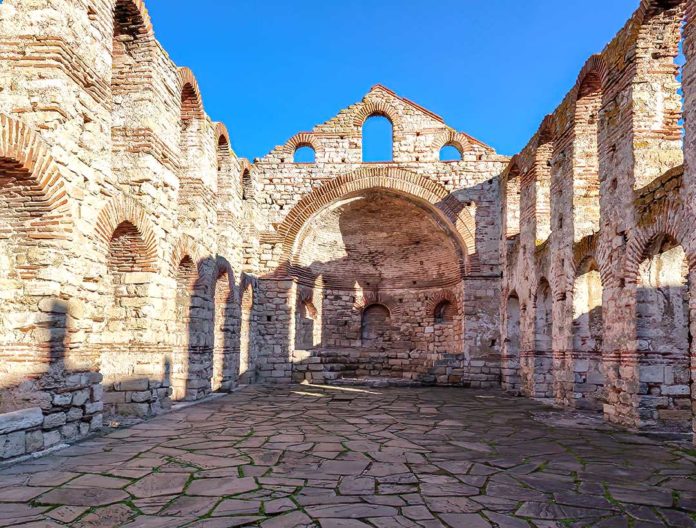Perched on a rocky peninsula jutting into the Black Sea, the Ancient City of Nessebar is a timeless jewel withstood the ravages of time and history. With a legacy of over 3,000 years, Nessebar is a living museum that tells the story of Thracians, Greeks, Byzantines, and Bulgarians who have all left their mark on this remarkable city. Today, as a UNESCO World Heritage site, Nessebar is not just a tourist destination but a testament to Bulgaria’s cultural and historical richness.
A Journey Through Time: From Thracian Settlement to Greek Colony
The origins of Nessebar trace back to an ancient Thracian settlement known as Mesembria. The Thracians, an Indo-European people, established the city more than 3,000 years ago. These early settlers fortified the town with impressive walls to protect it from invaders, and remnants of these Thracian fortifications still stand today, whispering stories of a distant past. Mesembria’s strategic location on the Black Sea made it an essential hub for trade and cultural exchange long before it became a thriving Greek colony.
It was not until the 6th century BC that Nessebar, then known as Mesembria, began to flourish under Greek influence. Greek colonists from Miletus arrived, and the city underwent a significant transformation. The Greeks brought their trade practices, culture, architecture, and religion with them. The remains from this Hellenistic period are still visible today, offering a fascinating glimpse into the city’s ancient past. The ruins of the Acropolis, the temple of Apollo, the agora (marketplace), and sections of the massive defensive walls are enduring testaments to Nessebar’s Greek heritage. These structures reveal the city’s importance as a religious, commercial, and cultural center in the ancient world.
A Byzantine Stronghold: Medieval Glory and Architectural Splendor
As centuries passed, Nessebar’s strategic importance only grew. During the Middle Ages, it emerged as a critical stronghold on the western coast of the Black Sea, becoming one of the most important towns in the Byzantine Empire. The city was fortified with new walls and towers, many of which still stand, demonstrating the Byzantine commitment to defending this vital port. Nessebar’s Byzantine period is particularly notable for its churches, which are among the best-preserved medieval monuments in the region.
The Stara Mitropolia Basilica, also known as the Old Bishopric, is one of the most significant remnants of this era. Built in the early Byzantine style, this basilica’s remains showcase the characteristic architectural elements of the period, including brickwork patterns and ornate decorations. Nearby, with its simple, unadorned exterior, the Church of St. John the Baptist contrasts sharply with the richly decorated interiors of later churches, reflecting the evolution of ecclesiastical architecture in Nessebar. Other notable medieval structures include the Church of Christ Pantocrator and the Church of St. Stephen, which boast intricate frescoes and elegant facades that illustrate the artistic and cultural achievements of the Byzantine period.
Nessebar in the Bulgarian Revival: A Blend of Cultures
Nessebar continued to evolve and adapt through the ages, and by the 19th century, it became a thriving center during the Bulgarian National Revival. This period was marked by a resurgence of Bulgarian culture, arts, and education, reflected in the city’s unique architectural style. The wooden houses of Nessebar, with their overhanging upper floors, stone foundations, and intricate wooden carvings, symbolize the Black Sea region’s architectural traditions. These houses, built by wealthy merchants and local artisans, exemplify a blend of traditional Bulgarian and Mediterranean influences, reflecting Nessebar’s diverse cultural heritage.
The narrow, winding cobblestone streets of the old town, lined with charming wooden houses, provide a window into the daily life of the 19th century. The houses are not just architectural treasures; they are living museums that capture the spirit of Nessebar during the Bulgarian Revival period.
A UNESCO World Heritage Site: Preserving the Legacy
Today, the Ancient City of Nessebar is a UNESCO World Heritage site recognized for its outstanding universal value. As visitors stroll through its ancient streets, they journey through time, from the ruins of Thracian fortifications and Greek temples to Byzantine churches and Bulgarian Revival houses. Every corner of Nessebar tells a story, and each stone is a piece of the mosaic that makes up the city’s rich historical tapestry.
Visitors to Nessebar can explore its many archaeological and historical sites, including the remains of ancient fortifications, medieval churches, and traditional Bulgarian houses. The city’s museums provide further insights into its storied past, showcasing artifacts from different periods, such as pottery, jewelry, and coins that highlight the city’s role as a commercial hub through the ages. Beyond its historical significance, Nessebar also offers breathtaking views of the Black Sea, with its rugged cliffs and serene waters providing a stunning backdrop to this ancient city.
A Treasure of Bulgaria
The Ancient City of Nessebar is not just a collection of ruins but a vibrant testament to the resilience and cultural richness of a city that has weathered the storms of history. Its layered past, visible in its architecture, ruins, and streets, makes it a unique destination for those interested in history, culture, and archaeology. Nessebar is more than a tourist attraction; it is a living chronicle of human civilization’s quest for identity, culture, and continuity. A visit to Nessebar is a journey through time, offering a rare opportunity to walk in the footsteps of Thracians, Greeks, Byzantines, and Bulgarians—a true treasure of Bulgaria that continues to captivate all who visit.



